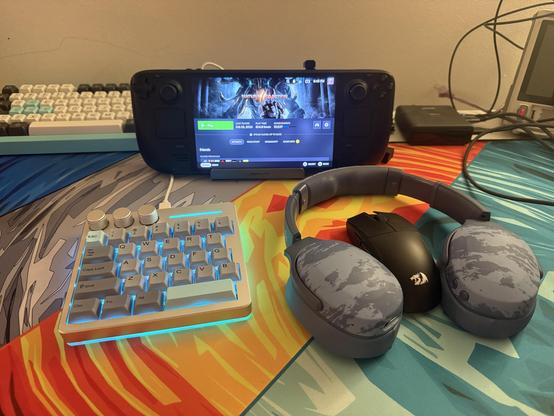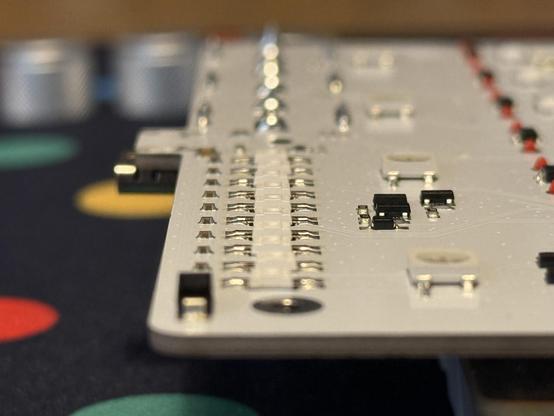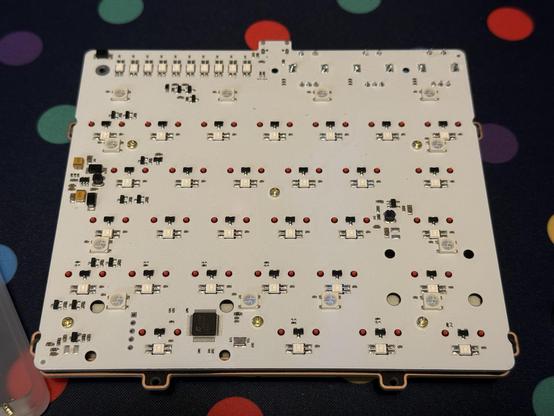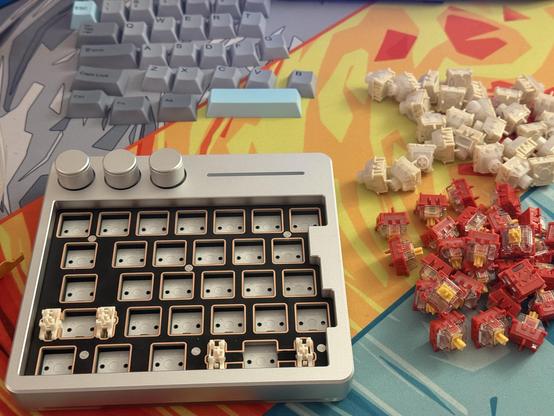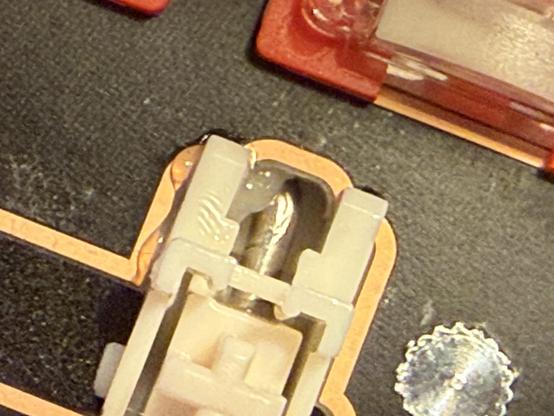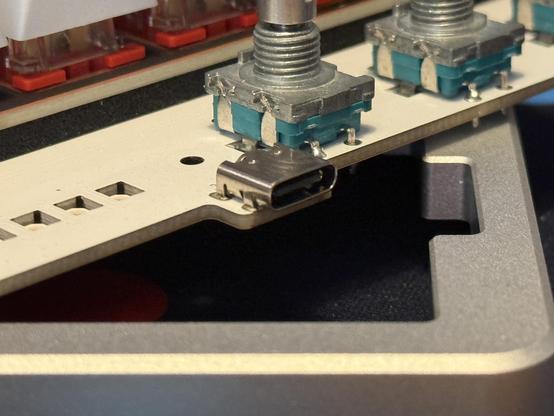KiiBOOM Cybrix29 – 29-key Hall-Effect, left-hand-only gaming keyboard
I was interested in the Cybrix29 mainly for one reason- to make fun of a quirky half keyboard that makes no sense. In fact my email to KiiBOOM asking to give it a try read: “tced aced te Cbrx 2 recet ad d ve t gve t a tr!” Get it?
In retrospect I have no idea what I actually wrote, but they’re playing 4D chess because they understood and asked me to confirm I was interested. And, y’know what, I am. Quirky stuff is my bread and butter. Technology feels so rote these days – imagine trying to find something to write about a ceaseless parade of black rectangles – that something a bit different really piques my interest.
In the time between asking for the Cybrix29 and receiving it, though, my rather skeptical approach, and intent to make fun of this quirky little thing, came crashing up against reality. Folks actually use separate keyboards for work/typing and gaming, and that totally makes sense. One of my biggest bugbears with Hall-Effect keyboards (and, in turn, magnetic switches) is that you’re confined to fairly uninspiring, linear-only switches. While there are magnetic switches I really like (see Wuque’s Flux, and also surprisingly the Outemu manufactured “Duskrise”) there’s a real lack of variety for typists.
The stock switches clash a little tonally with the board, but they are at least pretty decent.
But what if you just used two keyboards? Not a wholly bad idea, you can pick up a competent if joyless hall-effect keyboard for about £50 or even something a lot nicer.
Check out my sweet pro gamer setup!
But if desk space is at a premium and you only need a concise, left-handed gaming setup you can easily tuck away the Cybrix29 suddenly makes a lot of sense. The ubiquity of voice chat in modern gaming (not exactly a new development) means you don’t need a full keyboard to communicate (console gamers manage with precisely zero keyboard). And since it’s effectively one side of a split board, you can push it out to the left of your regular keyboard and keep your arms wide (Temba style) for a more comfortable setup. Or just tuck your regular keyboard away for tons of mousing space.
Build
With its CNC aluminium top and acrylic bottom the Cybrix29 is a clean, concise board. It isn’t dressed to impress, with the possible exception of the lighting of which there is an alarming quantity for such a small board.
With a gratuitous 10 RGB LEDs for a top-facing lightbar, RGB lighting for each key and RGB underlighting for the translucent acrylic base it still manages to scream gamer. The underlighting is on the main keyboard PCB so there’s no foam inside the case. Combined with its half-size, this also makes it very lightweight. 12 LEDs provide the underlighting and – predictably – 29 LEDs provide the per key RGB backlighting.
This board has a *lot* of LEDs!
The acrylic bottom has a lot of flex toward the middle and is stood away from the PCB just far enough to diffuse the lighting. It’s possible to squeeze it up against the PCB but since it’s not conductive this isn’t especially worrying.
It’s a very squat keyboard with a uniform height front-to-back. The lack of tilt options and no tilt by default might be a bit of a showstopper, though I didn’t seem to notice when actually gaming with it.
The three knobs, backed by continuous rotary encoders, have nice knurled metal caps with plastic inserts that friction fit onto the stems. An easy swap if you want to add your own customisations.
The “Duskrise” switches have a good firm feel allowing access to the full range of the analog, magnetic benefits of hall-effect. They are more or less exactly what I’ve been asking for with respect to firmness in a magnetic switch.
I swapped the stock switches back in for gameplay testing….
It turns out that extra 5g of bottom-out force makes a difference. “Duskrise” are also particularly muted, resulting in very quiet operation. They don’t have much bottom-out sound at all, and swapping them out for Wuque’s Flux makes this particularly obvious; the hollow, top-mount design of the board emphasizes the crisp, sharp clack of the Flux switches. I think I prefer the switches KiiBOOM decided to pair with Cybrix29, since typing sound is wholly unimportant when you’re – uh – jacked into a videogame. Their muted sound would be less objectionable to anyone else in the room- in my case, a desk in the corner of the bedroom.
Teardown
Secured by four very obvious crosshead screws concealed under the rubber feet on the acrylic bottom, but visible through the acrylic itself, the Cybrix29 is an easy teardown. The knobs, which are a simple friction fit, need to be pulled off first, but the acrylic bottom and aluminium top of the board separate cleanly. This reveals a top-mount design with the plate screwed firmly into the aluminium top shell by six crosshead screws split over the front, left and right edges and three additional screws through both the plate and PCB into the back edge. Since it’s just a small board this, in practise, makes the top plate and PCB assembly rock solid with no flex or give. This is probably the best setup for gaming, where precision is valued over bounce.
For once, an easy disassembly. At least until I lost a screw.
The plate and PCB are screwed together with a further six crosshead screws and separated by the usual foam. The stabilisers are plate mount, clip-in, and lubed like they’re about to have a colonoscopy.
The stabilisers have the typical abundant grease.
Since it’s a solid top-mount design with no options for sproingy mounting, the USB Type-C port is directly mounted to the main PCB on a little sticky-out lug. It seems reasonably secure, but perhaps the best mod you could do to this board right out of the box is to add some strain relief by means of some foam tape on the top of the USB Type-C port shield.
The USB port is attached directly to the main PCB- since it’s top mount and doesn’t move- and could perhaps use a little extra strain relief.
There’s nothing super interesting inside the Cybrix29, it’s an uncomplicated design without ribbon cables to tear or gaskets to lose. Surprisingly this makes for a rather decent sounding board, if sound is something you’re ever likely to care about over the audio of whatever game you might be playing.
Software
Put your dreams of setting up layered key binds and turning this thing into a chorded keyboard to rest. Sorry. The software is relatively basic and, with so many keys reserved for controlling all the backlights, you effectively have only one functional layer. The knobs offer some redemption, but a macro pad this ain’t. Since there are three lighting zones – backlight, light-bar and underlight (the naming of which is confused in the software) – it takes a lot of keys to offer full lighting control. The underlight cannot even be controlled in the desktop software, relying entirely on the keybinds.
The knobs, thankfully, are mostly quite useful with the left-most knob controlling PageUp/PageDown when turned (a slightly jerky but workable way of scrolling) and turning off *all* the lights when pressed (as much as I enjoy some RGB, they are a bit much). The middle knob offers music transport controls (possibly useful in-game) with Prev/Next on turn, and Play/Pause on click. Finally the right most knob offers volume control- you know how it goes. Re-binding the left knob to MouseWheel up/down sort of helps, but it doesn’t feel quite right scrolling web pages. It might be useful as a pseudo rapid-fire in-game if you’re a bind-your-pistol-to-mouse-wheel kinda player though. It actually kinda works well for thaaaaaaaaaaaaaaaaaaaaaaaaaaaat.
Of the 29 keys, only Esc, 1, 2, 3, 5, 6, W, E, Caps and Ctrl are assignable on Layer 1 (named just “Fn Layer” since there is only one), and everything else is marked out in red as a “System Key”. For those of us who want to set and forget the backlight, or don’t care about it at all, it would be nice to gain access to the other keys.
Weirdly 4 is assigned to Win+E (Explorer) by default, but also flagged as a system key- perhaps erroneously?- making it impossible to re-bind. A little awkward, since it’s right in the middle of the 123456 run and thwarts any efforts to make a sensible macro setup.
While hall-effect keyboards and their multi-trigger features effectively give you keys that can perform multiple functions depending on stroke depth, these have little practical use outside of specific games where you need to spam specific inputs or combinations of inputs.
On the upside the Fn key is placed where the Win key would ordinarily be, so you’ve no need to lock it and no risk of accidentally pressing it (is that still a thing… is anyone still gaming on Windows? Haha, sucks to be you.) On the downside, you cannot rebind this key. While there’s no visual cue to tell you this, attempting to do so will result in an “Fn Key Cannot Be Modified” error. Like, c’mon KiiBOOM I’m an adult here I can cope with not having *checks notes* “Toggle Lightbar Effects”.
On the upside there are some typical magnetic advanced key features, including Dynamic Key Stroke (DKS) which gives you different inputs at configurable downstroke and upstroke depths. Press and Click (MT which typically stands for Mod Tap, and is no more or less clear than Press and Click to be fair) which gives you a different input when held versus tapped. Gratuitous use of Mod-Tap can effectively give you another layer, but it’s a poor substitute for a key combo since the difference between a tap and a hold is finicky. Yes I did map the rest of my alpha keys using Mod-Tap. Yes it was tedious to set up. Yes it was just barely useful. Yes it would completely mess up your inputs in game. Finally Toggle Switch (TGL) for continuous rapid fire style inputs, and Snap Key (also known as SOCD or Simultaneous Opposite Cardinal Directions) which can help – among other things – make W and D mutually exclusive for slightly faster strafing.
Gaming
I suppose this review wouldn’t be complete without me actually gaming with the Cybrix29. Unfortunately my days of PC gaming are largely in the past, but I did suspect it would pair nicely with my Steam Deck for a few rounds of Natural Selection 2. Quaint? Somewhat. I was right, though, the Cybrix29 provided just enough keys – especially when coupled with a five button gaming mouse – for a fully functional, but compact gaming setup Any qualms I might have with the software became irrelevant since I had no need to bind anything at all. The Cybrix didn’t do anything for my terrible performance, but it didn’t do anything to hinder it either.
A little action shot. I played pretty comfortably like this for a while - a lucid moment between stomach bug and raging cold - though the Steam Deck screen isn’t great for situational awareness.
This might sound like damning with faint praise, but it’s half a keyboard… how revolutionary can it really be? The fact it saw me through an extended gaming session – whew it’s been a while since I played NS2 and I suuucked (sorry folks who had to put up with me) – is the lowest bar to clear. It cleared it.
Overall
Cybrix29 is a neat little board that fills a particular niche well, providing the tactile familiarity of a standard keyboard layout in a compact form-factor you can tuck alongside your workhorse board (or boards, ha!) I love the stock switches, and they are quiet enough that hammering away at my janky bedroom gaming setup did not elicit any complaints.
Sadly the mediocre software torpedoes any chance of getting fancy with this board- making layer 1 (Fn + key, the one and only “Fn Layer”) macros or bindings effectively impossible. Having so many keys reserved for lighting controls is quite silly, and they should really all be linked together as one, single, cohesive lighting setup that could be controlled by a single knob. I’ll pretty much set and forget my lights to some kind of teal blue every time anyway.
When actually gaming with this board all the key-binding and macro nonsense I might conceive to get involved in melts away. I don’t need it. If you’re also happy just to have standard, familiar WASD and accoutrements handy for some uncomplicated old-man gaming then you’re probably going to be fine. You’ll appreciate being able to tune the keyboard actuation depth, and you might find the knobs quite useful. It pairs great with a Steam Deck for some silly, unergonomic desktop gaming. That will, no doubt, be how I use it.
Unlike many weird half-a-board products out there the Cybrix29’s familiar layout of basically-half-a-keyboard means it doesn’t have a learning curve. You can just pick up and play and not have to adapt your muscle memory or – for the most part – worry about re-binding keys. That’s exactly what I did, and my hands didn’t know the difference between it and a full board. Granted there will always be a point at which you might need keys beyond T, G and B, or weapon quick selects or MMORPG character skills bound beyond 1 to 6- if you play these kinds of games… this board is not for you. If you’re playing relatively simple stuff, or even egregiously overcomplicated asymmetric shooters like NS2, then you’ll be fine.
In conclusion, software notwithstanding, I quite like the Cybrix29. I realise I quite like a lot of keyboards and that’s easy when you can send barely comprehensible emails asking for them in exchange for an arbitrary amount of blog waffle. But the concept is sound and the execution is- mostly- sound too. While I don’t have any hopes that they’ll punch up the software, it’s tolerable as is.
You can pick up the Cybrix29 for a penny (cent?) shy of $90 directly from KiiBOOM it’s also available from Amazon, but shipped/sold by Amazon US.

